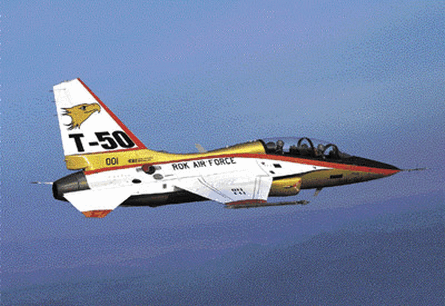Further delays are likely in the development of the Korea Aerospace Industries F/A-50 fighter, with the company unable to get its preferred radar and the South Korean government balking at the projected cost of the programme.
The design and production details of the aircraft - a combat version of KAI's T-50 advanced jet trainer - are almost complete and the company has lined up most of its suppliers. However, sources in South Korea say there are two impediments that could delay the start of the aircraft's development stage by more than a year to 2009.
 |
|---|
© KAI |
KAI and the South Korean air force want an active electronically scanned array radar on the F/A-50, but the USA has not allowed the technology to be exported despite several rounds of talks. Seoul must now decide between waiting for its preference and keeping the programme in limbo, or going ahead with a mechanically scanned array (MESA) and then fitting an AESA sensor on to later versions of the aircraft if Washington agrees.
"As far as the design and production are concerned, it is not a major issue. But this relates to the aircraft's capability and goes right to the heart of why the government should accept KAI's proposal for an F/A-50," says a source in Seoul. "It makes little sense to have some aircraft with MESA and others with AESA, even if the earlier aircraft can be upgraded in the future."
KAI had expected the go-ahead for the programme this year, paving the way for government funding. It has also been trying to lure Lockheed Martin, which helped to develop the T-50, given that it has no experience in developing fighters with advanced air-to-air and air-to-surface capabilities.
Lockheed's involvement, however, would increase the projected cost of the programme, causing the South Korean government to worry about the amount of funding it would need to provide, say sources. The parties involved are trying to find ways to reduce the cost, and convince the government that the price would be worth it.
"Some in South Korea feel that Lockheed is asking for too much money for its involvement. But KAI is keen to work with them, and their involvement may be crucial to the programme," says a Seoul-based source. "The Americans were instrumental in helping to develop the T-50 and making it a success. Discussions are ongoing, but the F/A-50 will cost less than its alternatives as it is based on the T-50 platform and that is likely to factor into the government's considerations."
KAI has been pushing for the development of the F/A-50 as a possible replacement for South Korea's Northrop F-5s, and hopes to secure an initial order for 60 aircraft, safeguarding its T-50 production line beyond 2012. Seoul has already committed to buying 60 T-50s and 22 armed A-50s.
Source: Flight International























